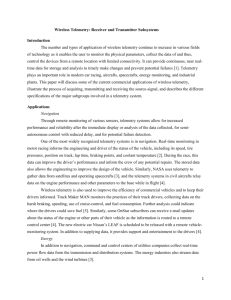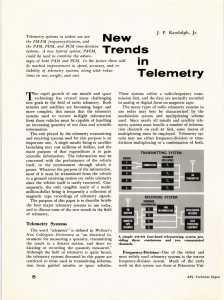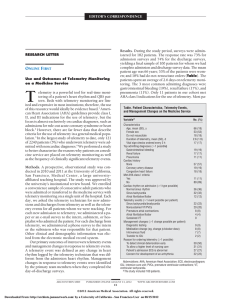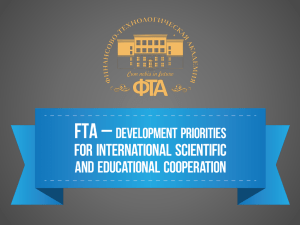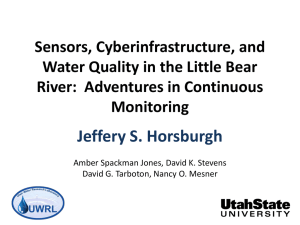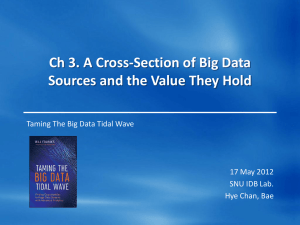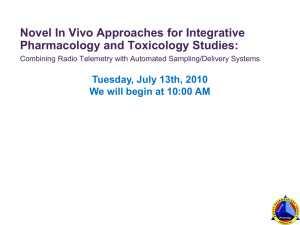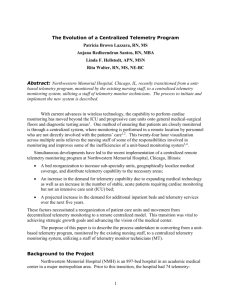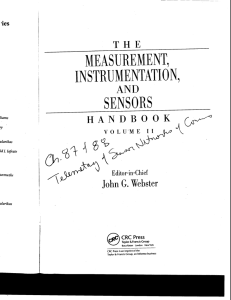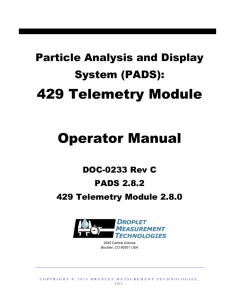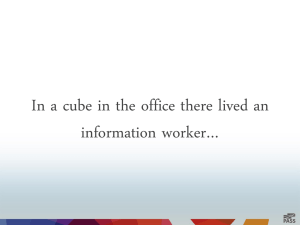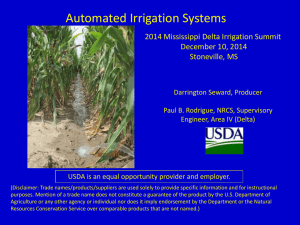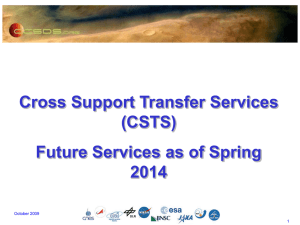Telemetry_module 1 - Prof. Dr. Joyanta Kumar Roy
advertisement
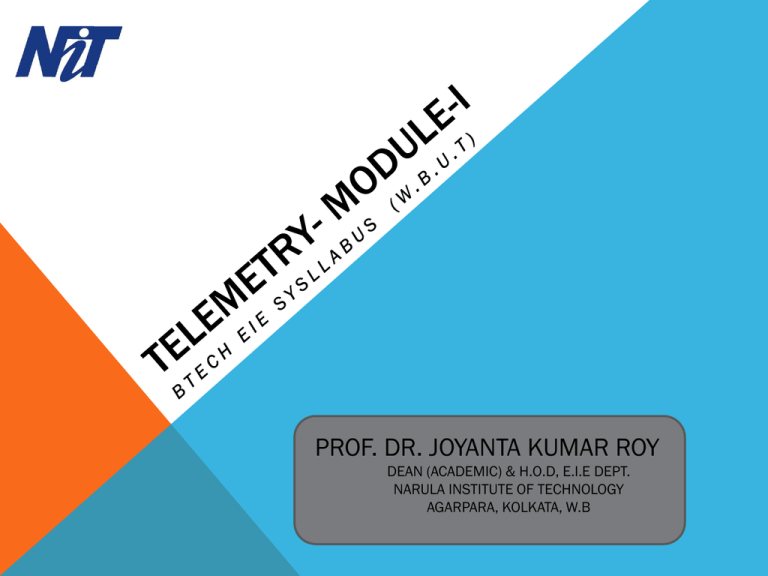
PROF. DR. JOYANTA KUMAR ROY DEAN (ACADEMIC) & H.O.D, E.I.E DEPT. NARULA INSTITUTE OF TECHNOLOGY AGARPARA, KOLKATA, W.B MODULE -I It will cover: • Purpose of telemetry, basic scheme, voltage, current and frequency telemetry • Concepts of Information transfer, bits, symbols, codes -source, line, channel, BCD, ASCII, BAUDOT, AMI, CMI, Manchester, HDBM, Block, Differential, Hamming, and Convolution. • Modulation codes: PAM, PFM, PTM, PCM CONCEPTS Definition Telemetry is the highly automated communications process by which measurements are made and other data collected at remote or inaccessible points and transmitted to receiving equipment for monitoring tele = remote, and metron = measure. HISTORY • Telemetering information over wire had its origins in the 19th century • The first data-transmission circuits was developed in 1845 between the Russian Tsar's Winter Palace and army headquarters • In 1874, French engineers built a system of weather and snow-depth sensors on Mont Blanc that transmitted real-time information to Paris • In 1912, Commonwealth Edison developed a system of telemetry to monitor electrical loads on its power grid. • The Panama Canal (completed 1913–1914) used extensive telemetry systems to monitor locks and water levels. • In 1930 Pavel Molchanov in Russia. Mochanov's system modulated temperature and pressure measurements by converting them to wireless Morse code. • Early Soviet missile and space telemetry systems which were developed in the late 1940s used either pulse-position modulation (e.g., the Tral telemetry system developed by OKB-MEI) or pulse-duration modulation (e.g., the RTS-5 system developed by NII-885). • In the US early work employed similar systems, but were later replaced by pulsecode modulation (PCM) (for example, in the Mars probe Mariner 4). Later Soviet interplanetary probes used redundant radio systems, transmitting telemetry by PCM on a decimeter band and PPM on a centimeter band. APPLICATION AREAS: • Meteorology Telemetry has been used by weather balloons for transmitting meteorological data since 1920 • Oil and gas industry Telemetry is used to transmit drilling mechanics and formation evaluation information up hole, in real time, as a well is drilled. These services are known as Measurement while drilling and Logging while drilling. Schlumberger's Pulse technology is an example of this. Tools like SlimPulse, PowerPulse, TeleScope, etc. use this methodology to send information acquired thousands of feet below ground. • Space science Telemetry is used by manned or unmanned spacecraft for data transmission. Distances of more than 10 billion kilometers have been covered, e.g. by Voyager 1. • Motor racing Telemetry is a key factor in modern motor racing, allowing race engineers to interpret data collected during a test or race and use it to properly tune the car for optimum performance. Systems used in series such as Formula One have become advanced to the point where the potential lap time of the car can be calculated, and this time is what the driver is expected to meet. Examples of measurements on a race car include accelerations (G forces) in 3 axes, temperature readings, wheel speed and suspension displacement. In Formula One, driver input is also recorded so the team can assess driver performance and (in case of an accident) the FIA can determine or rule out driver error as a possible cause. APPLICATION AREAS CONTD… • Agriculture Most activities related to healthy crops and good yields depend on timely availability of weather and soil data. Therefore, wireless weather stations play a major role in disease prevention and precision irrigation. These stations transmit parameters necessary for decisionmaking to a base station: air temperature and relative humidity, precipitation and leaf wetness (for disease prediction models), solar radiation and wind speed (to calculate evapotranspiration), water deficit stress (WDS) leaf sensors and soil moisture (crucial to irrigation decisions). This data really helpful for microclimate variation. • • Water management Telemetry is important in water management, including water quality and stream gauging functions. Major applications include AMR (automatic meter reading), groundwater monitoring, leak detection in distribution pipelines and equipment surveillance. Having data available in almost real time allows quick reactions to events in the field. Defense, space and resource exploration Telemetry is vital in the development of missiles, satellites, aircraft and resource exploration because the system might be destroyed during or after the test. Engineers need critical system parameters to analyze (and improve) the performance of the system. In the absence of telemetry, this data would often be unavailable. • Rocketry In rocketry, telemetry equipment forms an integral part of the rocket range assets used to monitor the position and health of a launch vehicle to determine range safety flight termination criteria (Range purpose is for public safety). Problems include the extreme environment (temperature, acceleration and vibration), the energy supply, antenna alignment APPLICATION AREAS CONTD… • Flight testing Flight test programs typically monitor data collected from on-board flight test instrumentation over a PCM/RF link. This data is analyzed in real time for safety reasons and to provide feedback to the test pilot. Challenges to telemetering this data include fading, multipath propagation and the Doppler effect. The bandwidth of the telemetry link is often insufficient to transfer all data acquired; therefore, a limited set is sent to earth for real-time processing while an on-board recorder ensures the full data set is available for post-flight analysis. • Military intelligence Telemetry was an important source of intelligence • Energy monitoring In factories, buildings and houses, energy consumption of systems such as HVAC are monitored at multiple locations; related parameters (e.g. temperature) are sent via wireless telemetry to a central location. The information is collected and processed, enabling the most efficient use of energy. Such systems also facilitate predictive maintenance. • Medicine Telemetry also is used for patients (biotelemetry) who are at risk of abnormal heart activity, generally in a coronary care unit • Fishery and wildlife research and management Telemetry is used to study wildlife, and has been useful for monitoring threatened species at the individual level. Animals under study can be outfitted with instrumentation tags, which include sensors that measure temperature, diving depth and duration (for marine animals), speed and location (using GPS or Argos packages). Telemetry tags can give researchers information about animal behavior, functions, and their environment This information is then either stored (with archival tags) or the tags can send (or transmit) their information to a satellite or handheld receiving device.
